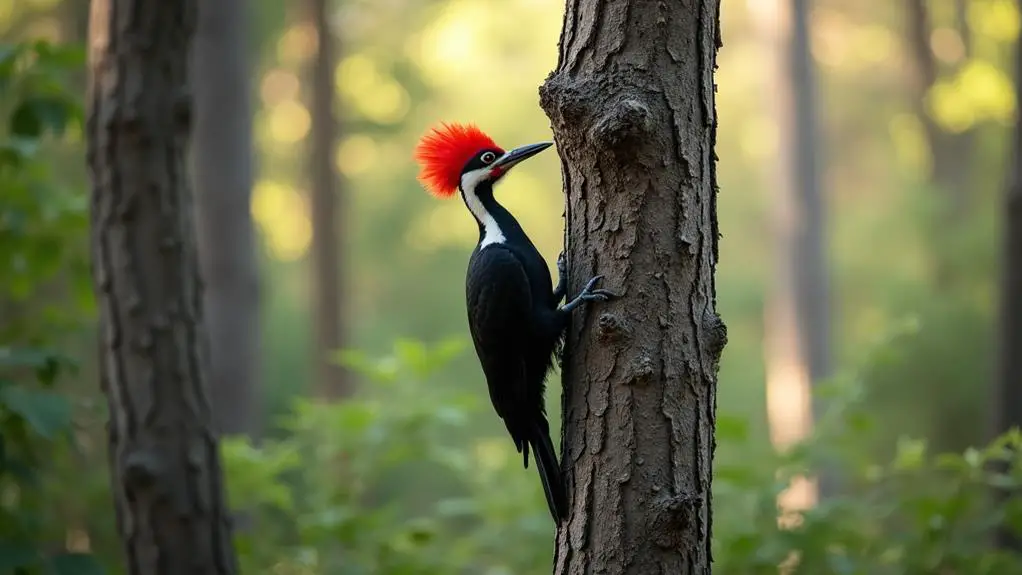As you step into Montana's vast wilderness, you're likely to encounter some of the most fascinating woodpeckers in North America. You might be wondering, which ones stand out from the rest? The answer lies in the unique traits of the Hairy, Downy, and Pileated Woodpeckers, each with characteristics that set them apart. From the Hairy's insistent drumming to the Downy's gentle nature, and the Pileated's impressive excavation skills, these woodpeckers are sure to capture your attention. But what makes them Montana's top 3, and what secrets do they hold?
Key Takeaways
- Montana's top 3 woodpeckers are the Hairy Woodpecker, Downy Woodpecker, and Pileated Woodpecker, each with unique characteristics.
- Hairy Woodpeckers are identified by their rapid, evenly spaced drumming pattern, which serves as a territorial marker and mating call.
- Downy Woodpeckers are the smallest in Montana, measuring 6-7 inches, and are recognized by their black and white plumage and gentle demeanor.
- Pileated Woodpeckers are the largest, ranging from 16-19 inches, and are known for their loud, resonant drumming and complex tunnel networks.
- These three woodpeckers can be found in Montana's forests, where they play a crucial role in controlling insect populations and maintaining ecosystem balance.
The Drumming Hairy Woodpecker

The Drumming Hairy Woodpecker
Drumming into trees, the Hairy Woodpecker announces its presence, a crucial behavior for establishing territory and attracting mates.
You'll notice that this woodpecker's drumming techniques are distinct from others, consisting of a series of rapid, evenly spaced beats.
This unique drumming pattern serves as an identifier, allowing you to distinguish the Hairy Woodpecker from other species.
As you observe the Hairy Woodpecker's habits, you'll find that drumming is an essential aspect of its daily routine.
Typically, drumming occurs during the breeding season, when males are vying for mates and defending their territories.
You might notice that drumming intensity increases during this time, with males drumming more frequently and for longer durations.
When examining Hairy habits, you'll discover that drumming isn't only limited to males.
Females also drum, although less frequently, and often in response to male drumming.
Downy Woodpecker Delights
You'll find the Downy Woodpecker's black and white plumage a striking contrast to its rather gentle demeanor.
This smallest of Montana's woodpeckers, measuring around 6-7 inches in length, is a common sight in forest habitats.
As you observe it, you'll notice its unique habit of tree climbing, often ascending and descending tree trunks in search of food.
The Downy Woodpecker's short, stiff tail feathers serve as a prop, allowing it to lean away from the trunk as it forages for insects and sap.
Its strong, chisel-like beak is perfectly adapted for excavating cavities in trees, providing a safe haven for nesting and roosting.
With its high-pitched "pik" call, the Downy Woodpecker communicates with its mates, often in the midst of its busy foraging routine.
As you explore Montana's forests, keep an eye out for this delightful woodpecker, and you might just catch a glimpse of its acrobatic antics.
Pileated Woodpecker Powerhouse

Woodlands of Montana are home to a behemoth of a bird, the Pileated Woodpecker, which flaunts its impressive size and striking red crest. You'll rarely find a bird that dominates its surroundings like the Pileated Woodpecker. As you venture into Montana's forests, you'll likely hear the drumming of this woodpecker, a sound that resonates through the trees.
The Pileated Woodpecker is a master of tree cavity excavation, creating complex networks of tunnels and chambers in search of insects and sap. This remarkable skill allows it to thrive in Montana's diverse forest habitats.
| Characteristic | Description | Importance |
|---|---|---|
| Size | 16-19 inches, 8-12 oz | Allows for efficient foraging and excavation |
| Plumage | Black with white stripes, red crest | Camouflage and visual display |
| Drumming | Loud, resonant drumming | Territorial marking and communication |
| Excavation | Complex tunnel and chamber networks | Access to insects and sap |
| Habitat | Mature, deciduous forests | Supports diverse insect populations
Frequently Asked Questions
What Do Woodpeckers Eat Besides Insects?
You'll find that woodpeckers' diets extend beyond insects to include fruit sources like berries, cherries, and apples, as well as sap consumption from trees, which provides essential nutrients and energy for their high-metabolism lifestyle.
Do Woodpeckers Make Good Pets?
You're considering woodpecker pet ownership, but it's essential to understand that woodpeckers don't form strong bonds with humans, making them unsuitable for petting; their natural behavior and social structure are incompatible with domestication, and captive care is often inhumane.
Can Woodpeckers See or Hear Well?
You'll find that woodpeckers possess exceptional sensory capabilities; their visual acuity is remarkable, with a wide field of vision, while their auditory range is impressive, allowing them to detect subtle sounds in their environment.
Why Don't Woodpeckers Get Headaches?
As you ponder the woodpecker's peculiar plight, you wonder why they don't get headaches from repeated ramming. It's due to their unique skull structure, which absorbs shock, and brain cushioning, a spongy cerebrospinal fluid that buffers the brain from impact.
Do Woodpeckers Migrate in Winter?
You might wonder if woodpeckers migrate in winter; research shows they exhibit partial migration, with some populations making short-distance movements, while others remain resident, adapting winter habits to survive, revealing complex migration patterns.
Conclusion
You've now met Montana's top 3 woodpeckers, each with their unique traits and habits. Interestingly, woodpeckers can drum up to 20 times per second, with the Hairy Woodpecker being a prime example. This remarkable behavior not only establishes territory but also attracts mates. With a deeper understanding of these fascinating birds, you'll appreciate their importance in maintaining Montana's forest ecosystem.





